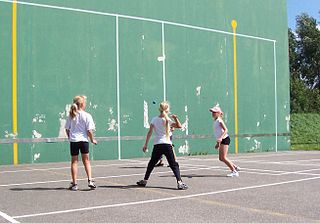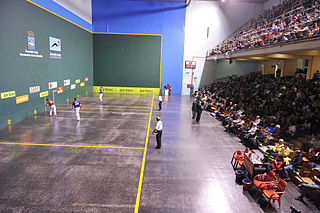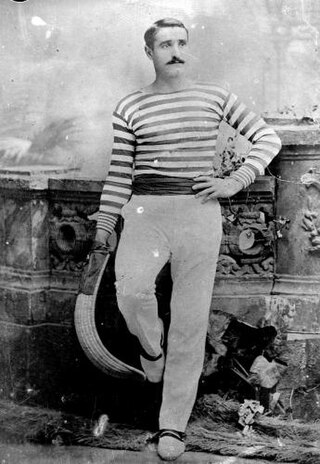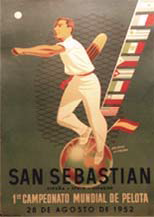
Jai alai is a sport involving bouncing a ball off a walled-in space by accelerating it to high speeds with a hand-held wicker cesta. It is a variation of Basque pelota. The term jai alai, coined by Serafin Baroja in 1875, is also often loosely applied to the fronton where matches take place. The game, whose name means "merry festival" in Basque, is called cesta-punta in the Basque Country. The sport is played worldwide, but especially in Spain, France, and in various Latin American countries.

Basque pelota is the name for a variety of court sports played with a ball using one's hand, a racket, a wooden bat or a basket, against a wall or, more traditionally, with two teams face to face separated by a line on the ground or a net. The roots of this class of games can be traced to the Greek and other ancient cultures.

Eibar is a city and municipality within the province of Gipuzkoa, in the Basque Country of Spain. It is the head town of Debabarrena, one of the eskualde / comarca of Gipuzkoa.

Alkiza is a rural municipality in the centre of Gipuzkoa, northwest of the Tolosaldea County, in the Basque Country. It is 27 kilometres south of San Sebastian. In 2019 it had 373 inhabitants, of which 88.8% were Basque speakers. Alkiza is an independent municipality since 1731; previously it depended on Tolosa and San Sebastian.
Julián Retegui Barbería, also known as Retegi II is an ex-player of Basque pelota. He is also called "El mago de Eratsun", since he is considered one of the best Basque pelota players of all time. He played as a foreplayer.

Valencian pilota is a traditional handball sport played in the Valencian Community. Its origins are not known.

One-wall handball, also known as 1-wall, wallball or international fronton is an indirect style of a ball game where the player hits a small rubber ball with their hand against a wall. The goal of the game is to score more points than the opponent. The player then hits the ball, and the ball bounces off the wall and the floor within court lines, if the opponent fails to return the ball, the player scores a point. The sport was created to bring varieties, such as American handball, Basque pelota, Patball, Gaelic handball, Pêl-Law and Valencian frontó.
Oier Zearra Garabieta, also known as Zearra, is a Basque pelota player for the Asegarce company. He plays as back-player.

Atano III is a Basque pelota short fronton located at the Anoeta Sports Complex in San Sebastián, Basque Autonomous Community, Spain.

Mariano Juaristi Mendizábal was an Azkoitian Basque pelota player known as Atano III. He is often considered one of the best pelotaris of all time, dominating the 1st hand-pelota category from 1926 to 1948 and winner of 4 championships.

Augusto Ibáñez Sacristán is a Basque pelota forward player. Champion of the Doubles Hand-pelota tournaments of 1994, 2000, 2004 and 2012.

Aimar Olaizola Apezetxea, known as Olaizola II is a pelotari, brother of Olaizola I.

Indalecio León Zarasqueta Uriarte, known as Txikito de Eibar or Aizpiri txiki, was a Basque pelota player who participated in pala, Hand-pelota, remonte, long bat and short bat categories. Due to his physical characteristics he received the nickname of Txiquito, meaning in Euskera Little. Txiquito de Eibar was one of the first professional players of pelota at the time of its beginnings, in the 19th century.

A fronton is a two-walled or single-walled court used as a playing area for Basque pelota.
Francisco Larrañaga Albizu, known as Txikito de Iraeta was a Basque pelota player, winner of the 1945 1st Hand-Pelota doubles championship.

The Beti Jai fronton is a sport venue located in Madrid, Spain.

Pelota Mano Court is a heritage-listed sports ground at Trebonne Road, Trebonne, Shire of Hinchinbrook, Queensland, Australia. It was designed by Ford, Hutton & Newell and built in 1959 by Idillio Quartero and Ken Duffy. It is also known as Basque Handball Court and Fronton (court). It was added to the Queensland Heritage Register on 27 July 2001.

Navarra Arena is an indoor sporting arena and fronton located in Pamplona, Spain. Its capacity is 9,808 people in the main court and 3,000 in the fronton.

The 1952 Basque Pelota World Championships were the 1st edition of the Basque Pelota World Championships organized by the FIPV.

There is an abandoned Jai alai court in the back of the Hermanos Ameijeiras Hospital, the site of the old Casa de Beneficencia, on Calles Concordia and Lucenas near Calle Belascoain, an area that had been considered in the early part of the city as a place to locate the helpless and the unwanted, it was the edge of the city and the countryside known as the "basurero"; the spectator stands were parallel to Calle Concordia, the front wall of the court faced Calle Lucenas, east in the direction towards Old Havana. The original building has been annexed by five stories of residential concrete construction on the north side along Calle Virtudes. The Havana Jai alai fronton was known as "the palace of screams".




















